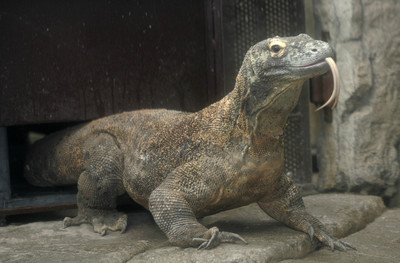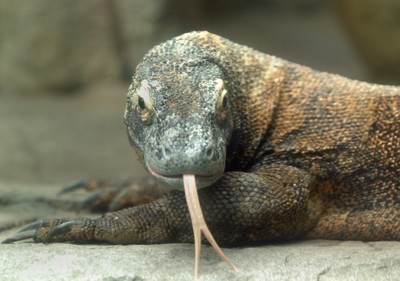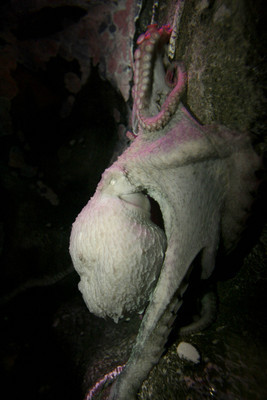Star Attraction
Warning, Strip visitors: Here be dragons.
With long, forked tongue tasting the air and a glacial gait that belies its true speed of up to 12 miles per hour, the Komodo dragon stares out at the crowd of people looking in at him.
With his beady little eyes and straight poker face, it's impossible to guess what he's thinking; then again, Komodo dragons aren't really known for their facial expressions. He seems curious about his new home at Mandalay Bay's Shark Reef, moving at an achingly slow pace to check it out before settling with splayed legs on a warming rock.
Regular meals and a hot rock: what more could a dragon ask for?
The 7-foot-long, 87-pound lizard is the Shark Reef's newest attraction, arriving in time to mark the aquarium's eighth anniversary on the Strip.
Though it may not seem like it goes with the aquarium's 2,000 other animals, including sharks, piranhas, jellyfish and stingrays, the Komodo dragon is a natural fit for Shark Reef, says curator Jack Jewell.
"It's something that's been in our plan for a long time," Jewell says. "We wanted something special, unique and predatory."
The Komodo dragon certainly meets those standards. It is an endangered species; only 3,000 to 5,000 are left in the wild, Jewell says. It's unusual, too, as only 75 are on display throughout the United States. And it is a rare predator in that it has no known predator of its own in the wild; its greatest threat is man.
The lizards -- they aren't really dragons -- were probably first discovered in the second century by Chinese traders who were sailing the waters in the southwest area of the Indonesian islands, according to draconian.com. They marked their maps with the vague and sinister words "here be dragons" as a warning to other travelers to beware of the creatures with long claws, forked tongues and scaly skin. The Komodo's natural habitat is Komodo Island and a few other islands in Indonesia.
The Komodo dragon is steeped in lore and thought to be the inspiration for the fire-breathing dragon myth, reef officials say. Though it doesn't breathe fire, its mouth is pretty dangerous as it contains about 50 different bacteria strains. Its bite alone doesn't kill; it's the festering and infected wound a victim develops that fells it, Jewell says. Komodo dragons are immune to the saliva of other Komodo dragons, which has inspired researchers to investigate the saliva and blood for its anti-coagulant and anti-bacterial potential.
The average male Komodo grows to about 7 feet long and reaches 88 pounds, although it can get as big as 10 feet and up to 200 pounds. People think of it as a man-eater but it's not, Jewell says. Instead, the Komodo prefers other smaller Komodo dragons, deer, fish and just about anything else that moves.
Mandalay Bay's Komodo dragon eats about three pounds of rats a week, Jewell says.
Since the Shark Reef opened in 2000, its focus has been on predatory aquatic animals. The goal, Jewell says, is to "educate, enlighten and preserve," especially those that are endangered or threatened in the wild.
With more than 1 million visitors a year, things have gone better for the aquarium than expected, Jewell says. There have been a few bumps along the way, such as the death of the aquarium's hammerhead shark in 2004. But they have continued to add new animals over the years and plan to add even more, Jewell says.
The aquarium's popularity still mystifies Jewell, although it shouldn't, he says.
"Sharks are a huge draw," Jewell says, referring to the 15 species that inhabit the waters at Shark Reef.
Although on this recent Friday, the Komodo dragon is all the rage, as is the Giant Pacific Octopus, which moved in last week.
Aside from a replacement hammerhead shark, one other thing has remained elusive to Shark Reef: A local following. The aquarium is a popular site for local school kids on field trips but largely, Las Vegas residents have stayed away. And that is one creature that Jewell would like to snare for the Shark Reef.
"Our mission was always to create a community-based attraction," Jewell says. "We all want that but it has been a challenge."
Locals don't like to visit the Strip because they view it as a hassle, Jewell says, but he's quick to point out the Shark Reef's location and price discount as reasons locals should visit. Mandalay Bay is located at the south end of the Strip and is easily accessed, Jewell says. Visitors can park right outside Shark Reef without having to walk through the casino and they pay $14.95 with a local ID.
But some visitors think the attraction is a value at the regular price of $16.95.
"Admission is cheaper than the glass of wine I had last night," says Jim Ledbetter, a visitor from Texas.
Contact reporter Sonya Padgett at spadgett@reviewjournal.com or 702-380-4564.



















